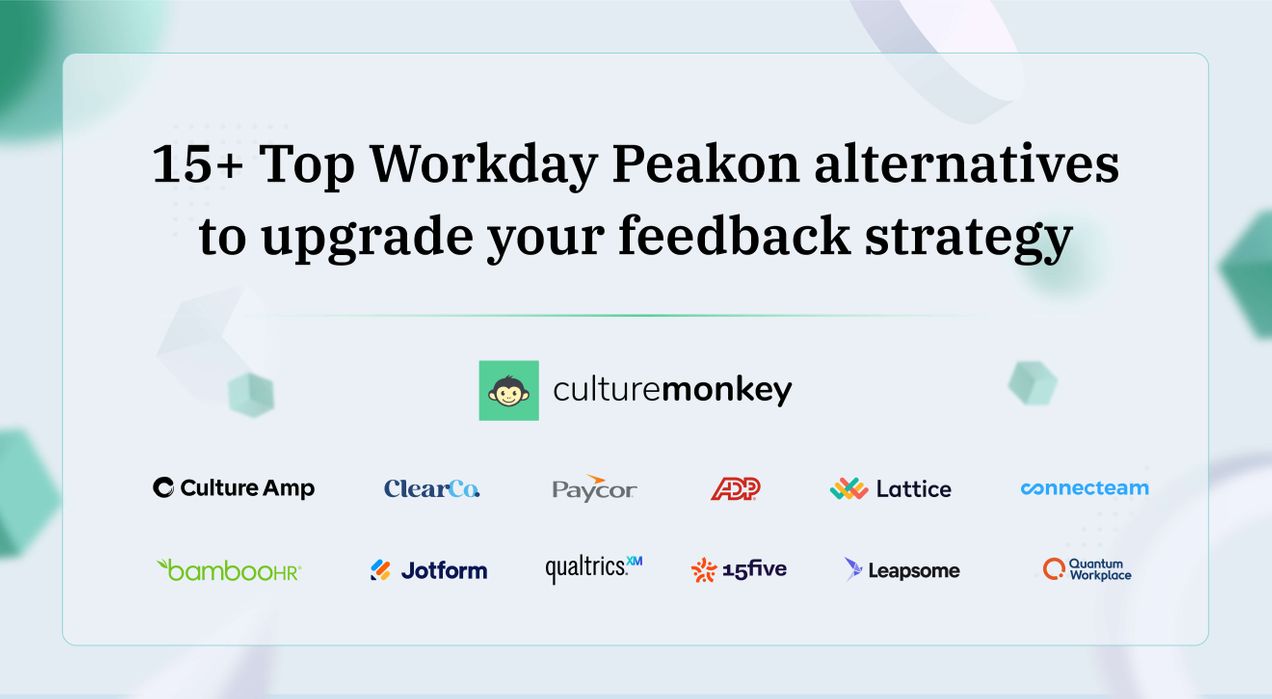Questionnaire for employee engagement survey: 75+ Expert-crafted questions to ask in 2025

Filling out a questionnaire is a lot like visiting a doctor for a health checkup. You answer a series of questions—not because the doctor doesn’t know what’s wrong, but because those details reveal what’s happening beneath the surface. Skipping questions or asking the wrong ones leaves blind spots, leading to half-baked conclusions.
The same holds true for employee engagement surveys. The questions you ask are the diagnostic tools, uncovering what drives motivation, where friction exists, and what employees truly need to thrive.
In 2025, getting these questions right isn’t just about gathering data—it’s about diagnosing culture and prescribing the right actions for growth.
TL;DR
What is an employee engagement survey?

TL;DR
An employee engagement survey is a structured way to measure how connected, motivated, and satisfied employees feel at work. It goes beyond surface-level feedback to uncover insights on culture, leadership, communication, and career growth.
These surveys help organizations understand employee needs, identify pain points, and take action that boosts morale and retention—ensuring every team member feels valued and aligned with business goals.
An employee engagement survey is a structured way to understand how connected, motivated, and employee satisfaction feels among employees feel at work. Unlike a simple employee opinion survey that focuses on surface-level sentiments, this type of survey digs deeper into what truly drives commitment—things like trust in leadership, employee development growth opportunities, workplace culture, and day-to-day experiences.
At its core, an engagement survey helps management go beyond assumptions. Leaders often believe they know what employees want, but real insights come when you ask direct, carefully crafted questions. By running an engagement survey, you uncover valuable insights on what boosts morale and what might be quietly causing disengagement. It’s not just about spotting problems—it’s about identifying strengths you can build on.
Think of it as a feedback loop: employees share their perspectives so employers can collect feedback and gain clarity on where to act. When done consistently, an employee engagement questionnaire becomes the foundation for shaping meaningful change. Whether through a broad work engagement survey or a more focused employee perception survey, the goal is the same—creating a workplace where the employee experience ensures employees feel heard, valued, and motivated to give their best.
Now that you know what an employee engagement survey is, let’s explore the exact questions that reveal what employees really think and feel.
The top 75+ employee engagement survey questions
Choosing the right questions is the backbone of any successful questionnaire for an employee engagement survey. The way you frame each question determines how honest, useful, and actionable the responses will be. By organizing over 75 employee engagement questions you can use, split into Likert scale and open-ended formats, around key drivers, HR leaders can uncover the real factors and employee engagement outcomes influencing engagement and retention.
1. Role clarity
A clear role keeps employees focused and confident. Without clarity, even the best employee engagement diagnostic tools give unreliable data.
Likert scale
- I clearly understand my job responsibilities (Strongly disagree — Strongly agree)
- I know what is expected of me at work (Very unclear — Very clear)
- I understand performance expectations (Very unclear — Very clear)
Open-ended
- What aspects of your role are most clear or unclear?
- How could the company better define your key responsibilities?
- What information would help you feel more confident in your job?
2. Recognition & appreciation
Recognition drives motivation and loyalty; essential for any staff engagement survey questions.
Likert scale
- I understand how my work contributes to the organization’s goals
(No connection — Very strong connection) - My work gives me a sense of accomplishment (Never — Always)
- I feel my work is meaningful (Not meaningful — Highly meaningful)
Open-ended
- What would help you feel more connected to the company’s purpose?
- How does your work impact the organization’s success?
- What could leadership do to show the importance of your role?
3. Career growth & learning
Career development keeps talent from leaving and makes a job engagement survey actionable.
Likert scale
- I have opportunities to develop new skills (Strongly disagree — Strongly agree)
- My organization fosters a culture of learning (Strongly disagree — Strongly agree)
- My manager supports my career growth (Strongly disagree — Strongly agree)
Open-ended
- What skills or training would help you grow here?
- What career development support do you need next?
- Describe what career growth means to you.
4. Leadership & trust
Strong leadership builds belief and keeps an employee experience questionnaire credible.
Likert scale
- Leadership inspires me to do my best work (Strongly disagree — Strongly agree)
- I trust the leadership team (Do not trust — Fully trust)
- Leadership communicates a clear vision for the future (Very unclear — Very clear)
Open-ended
- What could leadership do to earn more trust from you?
- How well does leadership explain company direction?
- What would make you feel more confident in leadership decisions?
5. Communication & feedback
Transparent communication keeps surveys for employees useful and honest.
Likert scale
- My manager communicates effectively (Strongly disagree — Strongly agree)
- The organization communicates important information clearly (Strongly disagree — Strongly agree)
- I am satisfied with communication between teams (Very dissatisfied — Very satisfied)
Open-ended
- How could communication be improved across the company?
- Describe a time when poor communication affected your work.
- What would make company updates clearer or more useful?
6. Performance support
Regular, constructive feedback drives improvement.
Likert scale
19. I receive adequate feedback on my performance (Strongly disagree — Strongly agree)
20. I feel comfortable sharing feedback with my manager (Strongly disagree — Strongly agree)
21. I am satisfied with the level of feedback I receive (Very dissatisfied — Very satisfied)
Open-ended
19. How could managers give you better feedback or support?
20. What feedback do you wish you received more often?
21. How can performance reviews be more helpful for you?
7. Belonging & culture
Belonging drives trust and honest associate engagement survey questions.
Likert scale
- I feel included and respected at work (Strongly disagree — Strongly agree)
- I feel a sense of belonging at work (Do not belong — Strongly belong)
- I feel safe expressing ideas or concerns (Never safe — Always safe)
Open-ended
- What makes you feel included and respected here?
- Have you ever felt excluded at work? Describe why.
- What would help the company feel more inclusive?
8. Enablement & resources
Enablement questions ensure work engagement surveys lead to action rather than frustration.
Likert scale
- I have the resources I need to perform my job effectively (Strongly disagree — Strongly agree)
- I have the tools needed to do my job efficiently (Strongly disagree — Strongly agree)
- My manager helps me overcome obstacles (Never — Always)
Open-ended
- What additional resources would help you perform better?
- Describe a tool or process that slows you down.
- How could the company make your work easier?
9. Work-life balance & well-being
Workload and balance questions keep an employment engagement survey meaningful and humane.
Likert scale
- My workload is manageable (Strongly disagree — Strongly agree)
- I have a healthy work-life balance (Very unhealthy — Very healthy)
- I feel I can disconnect from work when needed (Never — Always)
Open-ended
- How do you feel about your current workload?
- How can the organization better support work-life balance?
- What would make your schedule more sustainable?
10. Team collaboration
Strong teamwork drives productivity and morale.
Likert scale
- My team collaborates well to achieve goals (Strongly disagree — Strongly agree)
- Team members hold each other accountable (Never — Always)
- I have a good relationship with my coworkers (Very poor — Excellent)
Open-ended
- What changes would improve teamwork in your department?
- Describe a time your team worked really well together.
- How can managers support better collaboration?
11. Autonomy & empowerment
Trust builds ownership and motivation.
Likert scale
- I feel empowered to make decisions in my role (Strongly disagree — Strongly agree)
- I have the autonomy to make decisions in my role (No autonomy — Full autonomy)
- My manager trusts me to take initiative (Never — Always)
Open-ended
- Where would more autonomy help you succeed?
- Describe a time you felt trusted to lead.
- What decisions would you like more control over?
12. Motivation & pride
Pride and inspiration fuel long-term engagement.
Likert scale
- I feel motivated to do my best work every day (Strongly disagree — Strongly agree)
- I would recommend this organization as a great place to work (Would not recommend — Highly recommend)
- I am proud to work at this organization (Not proud — Extremely proud)
Open-ended
- What motivates you to stay with the organization?
- What would encourage you to be more engaged at work?
- Describe a moment when you felt proud to work here.
13. Culture & continuous improvement
Open, action-driven culture keeps surveys trusted.
Likert scale
- My organization fosters a culture of learning (Strongly disagree — Strongly agree)
- Management acts on employee feedback (Never — Always)
- I feel engaged in my day-to-day work (Strongly disagree — Strongly agree)
Open-ended
- What improvements would you suggest for company culture?
- Share suggestions to improve the employee experience.
- Describe a recent positive or negative culture change.
14. Purpose & impact
When employees see their impact, engagement and pride grow.
Likert scale
- I understand how my work contributes to the organization’s goals (No connection — Very strong connection)
- My work gives me a sense of accomplishment (Never — Always)
- I feel my work is meaningful (Not meaningful — Highly meaningful)
Open-ended
- What would help you feel more connected to the company’s purpose?
- How does your work impact the organization’s success?
- What could leadership do to show the importance of your role?
After picking the right employee engagement questions, it’s crucial to understand how the scale you choose can make or break the reliability of your employee engagement survey results.
Why your survey question scale shapes accurate employee engagement insights?

Imagine trying to measure distance with a rubber ruler. It stretches and shrinks, giving you no reliable answer. Here’s the short answer you came for, the scale you choose in a questionnaire for an employee engagement survey determines whether feedback turns into clear action or confusing noise for HR leaders and managers.
- Consistent responses: A clear employee engagement survey scale avoids confusion between “agree” and “strongly agree,” making results comparable across teams and time.
- Depth of sentiment: The right engagement questionnaire captures if employees feel slightly satisfied or deeply disengaged, helping HR prioritize improvements.
- Actionable insights: Precise scales turn survey data into clear actions to improve work engagement and employee satisfaction.
- Reduced bias: Balanced question scales prevent overly positive or negative results and show authentic employee sentiment for better culture decisions.
- Easy benchmarking: Standardized employee engagement survey questions allow trend tracking and industry comparison to measure real culture impact.
Once you’ve chosen a strong scale, the next challenge is deciding how to ask — should you leave room for free responses or stick to structured choices?
Open-ended vs. multiple-choice questions: Which works best in an employee engagement survey?

Imagine asking for directions and getting either a detailed story or a quick “turn left.” Here’s the short answer you came for, the strongest questionnaire for an employee engagement survey uses a blended approach that mixes open-ended and multiple-choice questions.
| Aspect | Open-ended questions | Multiple-choice questions | Blended approach |
|---|---|---|---|
| Depth | Captures emotions and hidden themes in an employee perception survey or employee experience questionnaire. | Limited nuance but easy to quantify. | Keeps free-text insights with clear trends in an employee engagement questionnaire sample. |
| Trust | Builds trust; boosts completion in any employee engagement questionnaire. | Feels structured but can seem restrictive. | Shows leaders value authentic stories while tracking metrics in work engagement surveys. |
| Fatigue | Can feel time-consuming in staff engagement surveys or job engagement surveys. | Quick to answer; keeps employment engagement surveys engaging. | Balances effort and value; fewer free-text items keep staff engaged. |
| Structure | Harder to compare across teams. | Provides clear benchmarks in employee engagement survey questionnaire samples or questionnaire on employee engagement. | Adds comparability while keeping context in employee engagement diagnostic tools. |
| Actionability | Explains why behind scores. | Creates clear metrics for work engagement surveys. | Gives HR both metrics and reasons to act on employee engagement survey questions and answers. |
| Culture change | Rich insight to improve recognition and growth. | Tracks trends over time. | Combines trends and stories to drive culture change. |
| Benchmarking | Harder to benchmark free text. | Supports industry comparisons and tracking of employee engagement questionnaire questions. | Allows benchmarking with context behind shifts in employee engagement survey questions. |
Knowing the right question formats is one thing; avoiding the wrong ones is just as critical for gathering honest, actionable feedback.
Do's and don’ts while framing engagement questions

Imagine building a bridge without testing its load. One weak beam can make the whole structure unsafe. Start here if you want quick, confident action. Framing the right questions in a questionnaire for an employee engagement survey to measure employee engagement keeps feedback clear and actionable.
| Do’s | Don’t’s | Why it matters |
|---|---|---|
| Keep questions clear and simple | Use complex wording | Clear questions give reliable data in an employee opinion survey, employee questionnaire, or team member engagement survey. |
| Focus on one idea | Combine multiple ideas | Single-topic staff engagement survey questions create cleaner, actionable results. |
| Use neutral language | Lead respondents | Neutral wording builds trust and makes engagement questionnaires and employee perception surveys more credible. |
| Provide balanced response options | Offer uneven scales | Balanced scales improve accuracy and benchmarking in work engagement surveys and associate engagement surveys. |
| Test questions before rollout | Launch without testing | Piloting ensures the employee engagement questionnaire template works across devices and cultures, avoiding drop-offs in surveys for employees and job engagement surveys. |
After learning what not to ask, you’ll want to ensure your remaining questions are clear, tested, and trusted before launching company-wide.
Types of questions to avoid in your employee engagement survey

TL;DR
Not every question belongs in an employee engagement questionnaire—some can bias answers, confuse employees, or even damage trust. Leading, vague, or overly personal questions dilute the quality of your insights.
By steering clear of such missteps, your engagement surveys for the workplace remain fair, relevant, and effective, ensuring employees feel safe to respond honestly while giving you actionable data you can rely on.
Imagine trying to measure trust with a tilted scale. No matter how accurate the numbers look, the results will always be off. The best employee engagement survey questions are fair, safe, and actionable while avoiding these common mistakes:
- Leading questions: Push employees toward a positive or negative answer. e.g., “How great is your manager at motivating you?”. They damage the credibility of an employee perception survey and reduce authentic feedback.
- Double-barreled questions: Combine two ideas at once. (e.g., workload and manager support). This confuses responses in a work engagement survey and prevents clear insights.
- Vague questions: Broad items like “Do you like your work?” provide little direction. They dilute the impact of staff engagement survey questions and weaken surveys for the workplace.
- Extremely personal questions: Sensitive items about finances or family issues make people uncomfortable. They lower trust in an employee opinion survey and reduce participation in employee engagement questionnaires.
- Complex or jargon-heavy questions: If wording is too technical, employees interpret it differently. This leads to inconsistent results in a team member engagement survey or associate engagement survey.
- Questions that compromise anonymity: Asking identifiable details (“Which manager do you disagree with most?”) breaks trust in anonymous employee engagement survey questionnaires and lowers future response rates.
After learning what not to ask, you’ll want to ensure your remaining questions are clear, tested, and trusted before launching company-wide.
How to test your questionnaire before launching it company-wide?

TL;DR
Before rolling out a questionnaire for employee engagement survey across the organization, testing is crucial to spot flaws and ensure clarity. Piloting with a small group helps identify confusing wording, scale issues, or irrelevant questions.
This process refines your employee engagement questionnaire, boosts accuracy, and builds employee confidence—so when the full launch happens, you gather reliable insights that truly reflect engagement levels.
Imagine rehearsing a play before opening night, a quiet run-through saves you from awkward mistakes on stage. To cut through the guesswork, realize that testing a questionnaire for an employee engagement survey with a small, mixed group can reveal clarity issues, platform bugs, and weak items before you send it company wide.
- Start with a representative pilot group: Include employees from different departments, seniority levels, and locations so the employee engagement questionnaire, staff engagement survey, or job engagement survey works in real-world conditions.
- Ask for clarity and fatigue feedback: Have testers flag confusing or repetitive employee engagement survey questions and employee involvement questionnaire items for long sections that can cause drop-offs.
- Review response trends for bias: Look for skipped questions or patterns where everyone selects the same option, a sign that employee perception survey or employee engagement survey questionnaire items may be vague or leading.
- Validate technology and accessibility: Ensure your survey platform works on mobile and desktop, supports multiple languages, and feels seamless for surveys for employees and associate engagement surveys.
- Refine and shorten weak items: Adjust wording, remove low-value questions, and balance scales so your final work engagement survey or employment engagement survey produces reliable, actionable data.
- Craft pre-launch communication: Use pilot insights to build manager briefs and employee invites explaining anonymity and purpose. This boosts trust and completion rates for any engagement questionnaire or employee questionnaire.
Once you’re confident in your survey content, you can save time by using pre-built, proven frameworks instead of starting from scratch.
Engagement is sinking anyway, why bother surveying?
Some executives argue that engagement is trending downward globally, so putting effort into new employee engagement questionnaires is a waste of time. After all, if 31% of U.S. workers are engaged and that’s the lowest in ten years, what difference will another survey make?
Gallup’s latest study reports that employee engagement in the U.S. hit its lowest level in a decade, with only 31% of employees classified as engaged in 2024.
But that doesn’t mean surveys are futile, it means they are more critical than ever. A well-crafted questionnaire, followed by visible action, helps leaders identify which engagement dimensions are failing (e.g. clarity, feedback, trust), tailor interventions, and turn the tide. Without measurement, you’re flying blind when engagement is already weakening.
CultureMonkey’s pre-built templates for fast and effective employee engagement surveys
Sometimes, building a questionnaire for an employee engagement survey from scratch can feel overwhelming. That’s where CultureMonkey’s pre-built templates come in—ready-to-use, research-backed, and designed to capture exactly what matters. Here’s why they’re worth considering for the sake of future success.
- Saves time without sacrificing quality: Instead of spending weeks drafting and editing, HR teams can pick from CultureMonkey’s expertly crafted templates. This ensures quick rollouts of surveys for employees without compromising on depth or accuracy.
- Covers diverse engagement themes: From leadership trust to career growth, templates include a wide range of staff engagement survey questions. This variety ensures you capture insights across all dimensions of engagement.
- Backed by research and benchmarks: The questions aren’t random—they’re based on proven engagement models and industry standards. This makes your employee opinion survey results more actionable and easier to benchmark against peers.
- Customizable to your culture: While the templates give a strong starting point, you can still tweak them. This flexibility allows you to tailor each team member engagement survey to reflect your organization’s values.
- Built for anonymity and trust: CultureMonkey templates are structured to ensure a secure and anonymous engagement survey experience, encouraging honest feedback from employees without fear of exposure.
- Globally adaptable: With built-in localization options, these templates make it easy to run an employee engagement questionnaire across global teams while respecting cultural nuances.
- Insight-driven dashboards: Post-survey, the templates feed into CultureMonkey’s analytics engine, turning responses into meaningful insights. This makes acting on your employee perception survey data faster and smarter.
Conclusion
Wrapping up, designing the right questionnaire for an employee engagement survey isn’t just about asking questions—it’s about asking the right ones, in the right way, and at the right time. From choosing effective scales to ensuring anonymity and leveraging AI, every detail contributes to capturing authentic employee voices.
A well-framed employee engagement questionnaire helps you understand what your people need to thrive, build trust, and take action that actually moves the needle. If you want to skip the trial-and-error and get started with research-backed, customizable, and globally adaptable templates, CultureMonkey has you covered.
Their pre-built surveys make it easier than ever to gather insights and boost engagement across your teams with confidence.
FAQs
1. What are good questions for an employee engagement survey?
Good questions should uncover how employees feel about leadership, career growth, recognition, and workplace culture. For example: “Do you feel valued at work?” or “Do you see long-term growth here?” Strong employee engagement questionnaire items are clear, unbiased, and aligned with your company goals, helping you gather actionable insights that drive meaningful changes to improve employee satisfaction.
2. Can I reuse the same questionnaire every year?
Yes, but with caution. Reusing the same questionnaire for an employee engagement survey allows year-over-year comparisons, but you risk survey fatigue if nothing changes. Refreshing some questions or adding new ones based on evolving business priorities keeps responses relevant. Balance consistency with adaptability to ensure your surveys remain engaging while still delivering comparable insights over time.
3. Are there ready-made templates I can use for employee engagement surveys?
Absolutely. Many platforms provide employee engagement questionnaire template options that save time and ensure research-backed quality. These templates cover a variety of themes like leadership, growth, or teamwork. Tools like CultureMonkey offer customizable templates, letting you tweak questions to match your culture while still benefiting from a professional starting point that’s ready for deployment, ultimately enhancing your company reputation.
4. How do I know if my questions are actually helping measure engagement?
The simplest way is to track outcomes after survey actions. If insights from your employee perception survey lead to noticeable improvements in morale, retention, or productivity, and employees feel they are fairly rewarded, your questions are effective. Poorly structured surveys, however, generate vague results. Pilot testing, data analysis, and correlating responses with real workplace outcomes help validate whether your questions measure engagement meaningfully.
5. Should engagement questions be different for different departments?
Yes. While some questions apply company-wide, tailoring parts of your engagement staff survey to specific functions increases relevance. For example, IT teams may care about workload balance, while sales teams may focus on incentives. Department-specific questions ensure you capture targeted insights about the workplace environment while still maintaining a core set of questions for overall engagement benchmarking across the organization.
6. Should engagement questions be anonymous?
Yes. Anonymous employee engagement survey questionnaires encourage candid, unbiased feedback and reduce fear of backlash. When employees trust their identity is protected, participation rises, and responses become actionable. Secure employee engagement diagnostic tools and clear communication about anonymity build confidence, enabling HR leaders to uncover honest insights and improve workplace culture, retention, and performance effectively.
7. How to localize your engagement survey for global teams?
Adapt your employee engagement questionnaire sample to cultural norms, language nuances, and local work practices. Use bias-free wording, professional translation, and pilot tests with diverse teams to measure employee engagement. Localizing an employee experience questionnaire ensures accuracy, respect for diversity, and actionable insights across regions. This approach helps HR leaders strengthen global culture while boosting engagement and retention worldwide.
8. How to choose an employee engagement survey tool?
Select a research platform with ready survey questions to measure and employee survey question templates offering multilingual support, data security, and advanced analytics. Look for customizable employee engagement questionnaire questions, pulse surveys, and seamless HRIS integrations. The right employee involvement questionnaire turns raw responses into clear strategies that improve culture, retention, productivity, and trust while keeping engagement measurement consistent.



